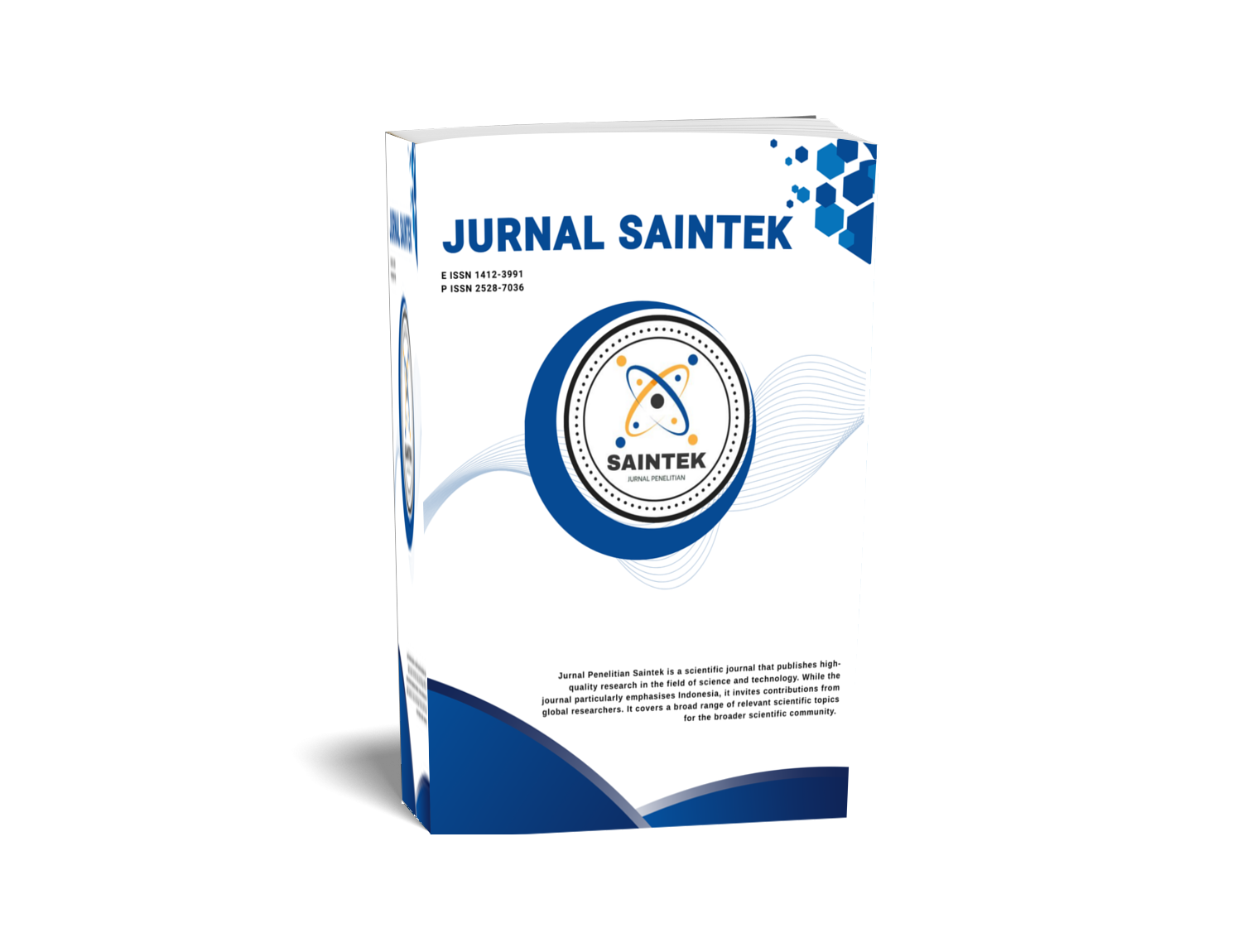MODIFIKASI KAIN AKTIF ANTIBAKTERI BERBASIS KOMPLEK Mn(II) BASA SCHIFF KITOSAN–SALISILALDEHID
DOI:
https://doi.org/10.21831/jps.v25i1.29821Keywords:
kitosan, kompleks basa Schiff, rasio substitusi, antibakteriAbstract
Penelitian ini bertujuan untuk memperoleh kompleks Mn(II)-basa Schiff kitosan-salisaldehida dan menguji aktivitasnya sebagai bahan aktif kain antibakteri. Metode penelitian dilakukan melalui tiga tahapan. Pada tahap pertama dilakukan sintesis basa Schiff kitosan–salisilaldehid dengan mereaksikan kitosan dengan variasi mol salisilaldehid menggunakan campuran pelarut asam asetat dan etanol, diaduk pada suhu 50oC selama 6 jam. Pada tahap kedua, basa Schiff kitosan–salisilaldehid dijadikan kompleks dengan MnCl2.2H2O menggunakan campuran pelarut asam asetat 2% dan etanol, diaduk pada suhu 60oC selama 12 jam. Pada tahap ketiga dilakukan pelapisan kompleks pada kain katun menggunakan metode spray dan selanjutnya dilakukan uji antibakteri terhadap E. coli (G-) dan S. aureus (G+) menggunakan metode difusi cakram. Hasil penelitian menunjukkan bahwa basa Schiff kitosan–salisilaldehid dengan rasio substitusi paling besar (0,122) diperoleh ketika disintesis menggunakan salisilaldehid 0,00227 mol. Senyawa kompleks Mn(II)-basa Schiff kitosan–salisilaldehid yang terbentuk berupa serbuk berwarna hitam dengan rendemen 66%. Kain katun yang telah dilapisi kompleks Mn(II)-basa Schiff kitosan–salisilaldehid efektif menghambat pertumbuhan bakteri dengan persen daya hambat sebesar 16,02% terhadap bakteri E. coli (G-) dan 14,02% terhadap bakteri S. aureus (G+).
MODIFICATION OF ANTIBACTERIAL FABRIC FROM Mn(II) SCHIFF BASE CHITOSAN - SALICYLALDEHYDE COMPLEX
This study was aimed at obtaining the complex of Mn(II)-Schiff base chitosan- salicylaldehyde and evaluating the activity of antibacterial agent on cotton fabric. The study was conducted through three treatment steps. In the first step, chitosan-salicylaldehyde Schiff base was synthesized by reacting chitosan with mole variations of salicylaldehyde and combined with a mixture of acetic acid and ethanol as the solvent which was then stirred at 50oC for 6 hours. In the second step, preparation complexes Mn(II)- Schiff base chitosan-salicylaldehyde was conducted by mixing chitosan-salicylaldehyde Schiff base and MnCl2.2H2O using acetic acid 2% -ethanol as a solvent at 60oC for 12 h. In the third step, the complex was coated onto fabric using spray method and the E. coli (G-) dan S. aureus (G+) antibacterial test was done to the coated fabric using disk diffusion method. The results showed that 0.00227 mole salicylaldehyde lead to the highest substitution ratio of Schiff base chitosan-salicylaldehyde of 0.122. The Mn(II)-Schiff base chitosan-salicylaldehyde complex was obtained as black powder with a yield of 66%. Cotton fabric that has been coated with the complex, effectively inhibits bacterial growth with a percent inhibition against E. coli (G-) and S. aureus (G+) bacteria of 16.02% and 14.02%, respectively.
References
Al-Issa, M. A., Abbas, A. A., & Matty, F. S. (2017). Synthesis and characterization of schiff base derived from chitosan and its complexes with (Co+ 2, Ni+ 2 and Cu+ 2). Ibn AL-Haitham Journal For Pure and Applied Science, 29(2), 115-129.
Barbosa, H. F. G., Attjioui, M., Ferreira, A. P. G., Dockal, E. R., El Gueddari, N. E., Moerschbacher, B. M., & Cavalheiro, í‰. T. G. (2017). Synthesis, characterization and biological activities of biopolymeric Schiff bases prepared with chitosan and salicylaldehydes and their Pd (II) and Pt (II) complexes. Molecules, 22(11), 1987.
Callewaert, C., De Maeseneire, E., Kerckhof, F. M., Verliefde, A., Van de Wiele, T., & Boon, N. (2014). Microbial odor profile of polyester and cotton clothes after a fitness session. Applied and environmental microbiology, 80(21), 6611-6619.
Joseyphus, R. S., & Nair, M. S. (2008). Antibacterial and antifungal studies on some schiff base complexes of zinc (II). Mycobiology, 36(2), 93-98.
Lopez-Romero, J. C., González-Ríos, H., Borges, A., & Simíµes, M. (2015). Antibacterial effects and mode of action of selected essential oils components against Escherichia coli and Staphylococcus aureus. Evidence-Based Complementary and Alternative Medicine, 2015.
Matar, S. A., Talib, W. H., Mustafa, M. S., Mubarak, M. S., & AlDamen, M. A. (2015). Synthesis, characterization, and antimicrobial activity of Schiff bases derived from benzaldehydes and 3, 3"²-diaminodipropylamine. Arabian Journal of Chemistry, 8(6), 850-857.
Miller, S. I., & Salama, N. R. (2018). The gram-negative bacterial periplasm: Size matters. PLoS biology, 16(1), p. e2004935.
Pervaiz, M., Ahmad, I., Yousaf, M., Kirn, S., Munawar, A., Saeed, Z., ... & Rashid, A. (2019). Synthesis, spectral and antimicrobial studies of amino acid derivative Schiff base metal (Co, Mn, Cu, and Cd) complexes. Spectrochimica Acta Part A: Molecular and Biomolecular Spectroscopy, 206, 642-649.
Rachmawati, I. E., Ngadiwiyana, & Ismiyarto. (2017). Sintesis turunan azomethin sebagai zat aktif inhibitor korosi pada logam menggunakan bahan dasar piperonal dan 2-aminopiridin. Jurnal Kimia Sains dan Aplikasi, 20(3), 136-139.
Silhavy, T. J., Kahne, D., & Walker, S. (2010). The bacterial cell envelope. Cold Spring Harb Perspect Biol., 2(5): a000414.
Verlee, A., Mincke, S., & Stevens, C. V. (2017) Recent developments in antibacterial and antifungal chitosan and its derivatives. Carbohydrate Polymers, 164, 268-283.
Downloads
Published
How to Cite
Issue
Section
Citation Check
License
Who Can Submit?
Any individual may submit an original manuscript for consideration for publication in Jurnal Penelitian Saintek as long as they hold the copyright to the work or are authorized by the copyright owner(s) to submit it. Authors retain initial ownership of the copyrights to their works prior to publication, except in cases where, as a condition of employment, they have agreed to transfer copyright to their employer.
User Rights
Jurnal Penelitian Saintek is an Open Access journal. Users are granted the right to read, download, copy, distribute, print, search, or link to the full texts of articles, provided they comply with the conditions of the Creative Commons Attribution-ShareAlike License 4.0 (CC BY-SA 4.0).
https://creativecommons.org/licenses/by-sa/4.0/
Author Rights
Authors retains copyrights.
Jurnal Penelitian Saintek by http://journal.uny.ac.id/index.php/saintek is licensed under a Creative Commons Attribution-ShareAlike 4.0 International License.









